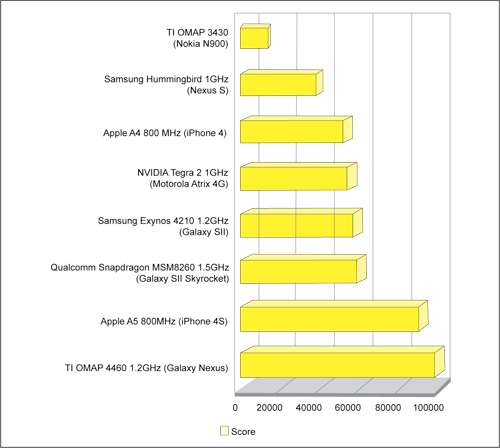Unlike the infated BrowserMark score for the Apple A5, GLBenchMark score is accurate because the A5 does feature a high-end dual-core GPU.
Benchmark trends
If you look at the top three scoring SoCs (refer Fig. 2), you would find tha clock speed does not define performance. Snapdragon MSM8260 despite claiming the highest clock speeds of 1.5 GHz still rates less than Apple A5 SoC running at 800 MHz (though there is a slight advantage due to the Safari-BrowserMark bug).


The reason why MSM8260 lost even with the spruced-up clock speed is that this SoC is based on ARM’s Cortex-A8 design. The other two SoCs that beat it are based on the Cortex-A9, which is known to perform 20 per cent better than A8. This result also shows why you should not compare performance of processors having different architecture based on clock speed alone. A better way to do so is to compare the performance per clock of the chips.
In the graphics benchmark (refer Fig. 3), Apple’s A5 wins hands down with its PowerVR SGX543MP2 graphics solution. Obviously it’s because this is a dual-core GPU. Moreover, SGX540 (belongs to Series 5) used in OMAP4460 was released around two years before the SGX543 (belongs to Series 5XT). As the chips used were from different generations, it was not a fair fight.
Within the single-core GPUs, Mali-400 outperformed SGX540, ULP GeForce and Adreno 220 by a wide margin. But since most of the popular games out in the Android market are running Tegra 2 optimised versions, the real-life performance from a gaming perspective would be far better than what was benchmarked here.
Based on the two benchmarks, the overall score performance of different SoCs is provided on the next page.

[stextbox id=”info” caption=”Current SoCs”]
TI OMAP3430

TI OMAP3430 features an ARM Cortex A8 processor clocked at 600 MHz. ARM Cortex A8 processor is based on the ARMv7 architecture and is claimed to scale in speed from 600 MHz to greater than 1 GHz. In fact, many people run hacked kernels where the processor is overclocked from 600 MHz to 1.15 MHz. The down-side, however, is that the SoC uses a lot of power as its clock gets scaled up.
This processor also supports a super-scalar micro-architecture with NEON technology for SIMD processing.
Samsung Hummingbird 1GHz

Samsung Hummingbird too is based on the ARM Cortex A8 architecture, albeit at a smaller 45nm process than the TI OMAP 3430. It was jointly developed along with Intrinsity. Intrinsity tweaked the CPU by trimming inefficiencies in the way logic gates are used by using 1-of-n domino logic (NDL). Due to this, the Hummingbird CPU delivers not only high media and data crunching performance in mobile devices but lowered power consumption as well.
Hummingbird comes with 32 kB of both data and instruction cache, a variable-size L2 memory cache and the ARM NEON multimedia extension. This SoC features a PowerVR SGX 540 GPU.
Apple A4 800MHz

Apple A4 SoC is based on the ARM architecture. It is designed by Apple and manufactured by Samsung. It combines an ARM Cortex-A8 CPU with a PowerVR GPU and emphasises power efficiency. The chip made a commercial debut with the release of Apple’s iPad tablet, followed shortly by the iPhone 4 smartphone, the fourth-generation iPod Touch and the second-generation Apple TV.
The A4 processor package does not contain RAM but supports point-of-purchase (PoP) installation. This allows the different devices which utilise it to have different RAM configurations,like 256MB low-power DDR SDRAM for the iPad and 512MB low-power DDR SDRAM for the iPhone 4. The SoC features a PowerVR SGX 535 GPU.
NVIDIA Tegra 2 1GHz

The NVIDIA Tegra 2 is a dual-core SoC that features an ultra-low-power (ULP) NVIDIA GeForce GPU with four pixel shaders and four vertex shaders. The processor within is actually a dual-core ARM Cortex-A9 CPU. The Cortex-A9 is 25 per cent Dhrystone MIPS faster than Cortex-A8. Cortex-A9 runs 1 GHz per core and has a 1MB L2 cache as well as one 32kB L1 cache per core. The GPU is a fully programmable OpenGL ES 2 supporting processor with eight cores. Tegra 2 being a NVIDIA product, a lot of Android games are believed to be optimised for it.







